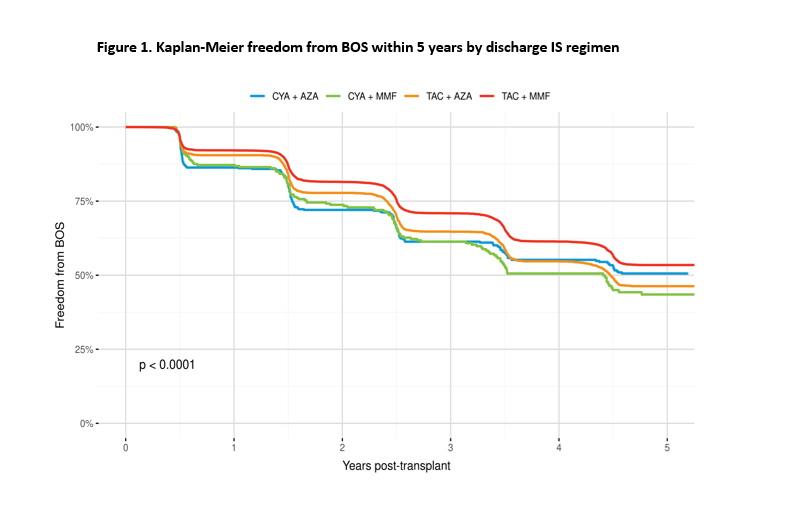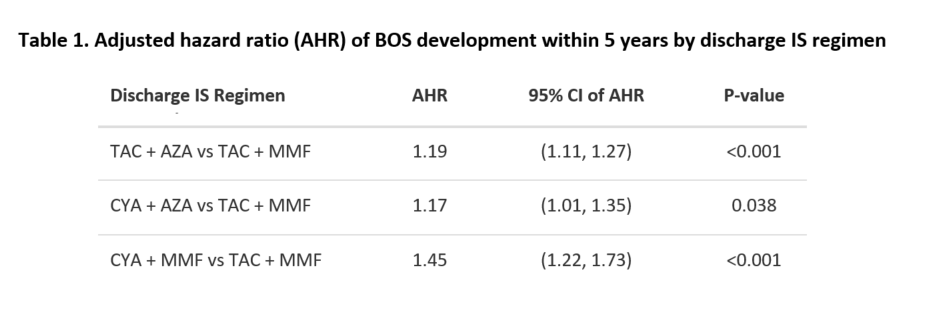Association of Discharge Immunosuppressive Regimen with Treated Acute Rejection and Bronchiolitis Obliterans Syndrome in Adult Lung Transplantation: An Analysis of Organ Procurement and Transplantation Network Data
1United Network for Organ Sharing, Richmond, VA, 2Duke University Hospital, Durham, NC, 3Fitzsimmons LLC, Vernon Hills, IL
Meeting: 2020 American Transplant Congress
Abstract number: C-296
Keywords: Immunosuppression, Lung transplantation, Multivariate analysis, Outcome
Session Information
Session Name: Poster Session C: Lung: All Topics
Session Type: Poster Session
Date: Saturday, May 30, 2020
Session Time: 3:15pm-4:00pm
 Presentation Time: 3:30pm-4:00pm
Presentation Time: 3:30pm-4:00pm
Location: Virtual
*Purpose: The optimal immunosuppressive (IS) regimen after lung (LU) transplant is unknown. We conducted the current analysis to compare the effect of four different discharge IS combinations on outcomes of treated acute rejection (AR) and bronchiolitis obliterans syndrome (BOS).
*Methods: We used the Organ Procurement and Transplantation Network (OPTN) data for adult recipients of primary, deceased donor, LU alone transplants during 2005-2015, who were alive at discharge and on one of the following discharge IS regimens: cyclosporine + azathioprine (CYA+AZA), cyclosporine + mycophenolate mofetil (CYA+MMF), tacrolimus + azathioprine (TAC+AZA), or TAC+MMF. Treated AR within 1 year was compared by IS regimen using a chi-square test. Freedom from BOS within 5 years was estimated using Kaplan-Meier method and compared by IS regimen using a log-rank test. Cox regression analysis was performed to assess the association of IS regimen and BOS, adjusted for other covariates. The results of the Cox model are presented as adjusted hazard ratio (AHR), 95% confidence interval (CI) of AHR, and p-value.
*Results: Of 14,798 recipients in the study cohort, 10,842 (73%) were on TAC+MMF, 2,968 (20%) on TAC+AZA, 587 (4%) on CYA+AZA, and 401 (3%) were on CYA+MMF. There was a significant difference in the one-year rates of treated AR across IS regimens (56% for CYA+AZA, 36% for CYA+MMF, 32% for TAC+AZA, and 27% for TAC+MMF) (p<0.0001). Figure 1 shows that unadjusted freedom from BOS was significantly different across IS regimens. The adjusted Cox regression model showed that TAC+MMF was associated with a significantly decreased risk of BOS within 5 years compared to the other three regimens (Table 1).
*Conclusions: In this retrospective OPTN registry analysis, TAC+MMF was associated with a lower rate of unadjusted one-year treated AR and reduced, adjusted risk of BOS within 5 years compared to the other regimens. Limitations of this analysis included small numbers of patients in some of the IS groups and not accounting for changes in the IS regimen after discharge.
To cite this abstract in AMA style:
Cherikh WS, Plucinski BJ, Palmer S, Fitzsimmons WE. Association of Discharge Immunosuppressive Regimen with Treated Acute Rejection and Bronchiolitis Obliterans Syndrome in Adult Lung Transplantation: An Analysis of Organ Procurement and Transplantation Network Data [abstract]. Am J Transplant. 2020; 20 (suppl 3). https://atcmeetingabstracts.com/abstract/association-of-discharge-immunosuppressive-regimen-with-treated-acute-rejection-and-bronchiolitis-obliterans-syndrome-in-adult-lung-transplantation-an-analysis-of-organ-procurement-and-transplantatio/. Accessed December 24, 2025.« Back to 2020 American Transplant Congress


